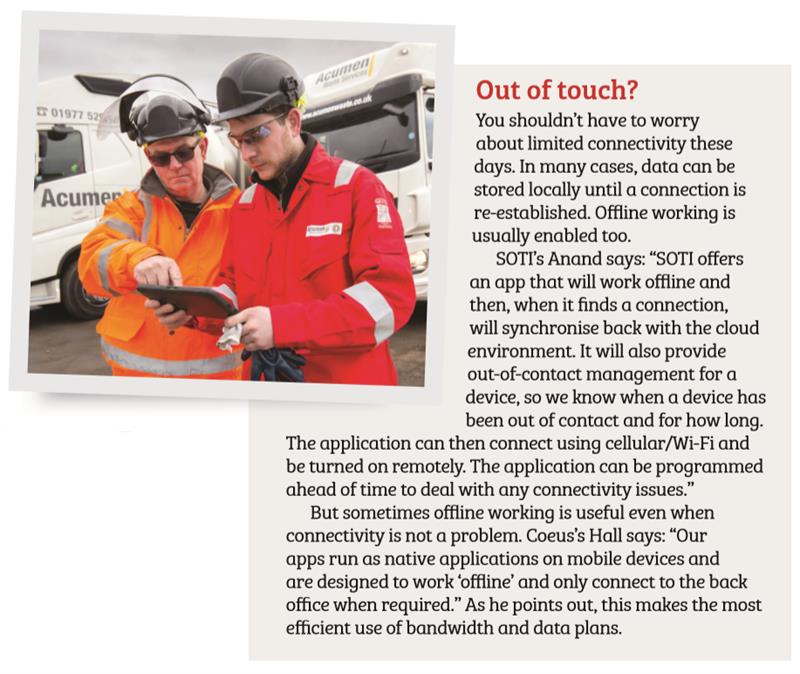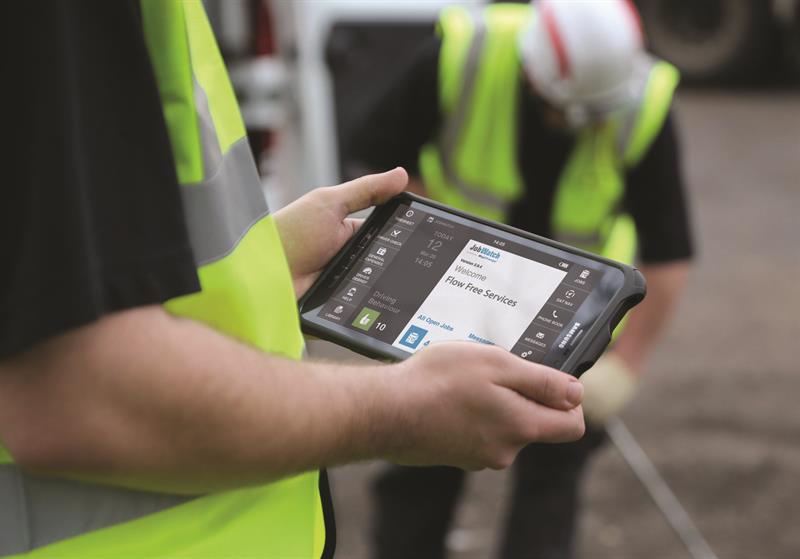If you have yet to consider procuring mobile working apps, there is one obvious justification for such an investment.
Colin Yates, chief support officer at WorkMobile, a leading name in the mobile form field that offers what it calls ‘an award-winning mobile data capture app’, says: “Paper-based processes are inefficient, time-consuming and costly. They can also result in inaccuracies and inconsistencies when collecting data, and greatly increase the risk of important documents being damaged or misplaced.”
Simon Hall is CEO of Coeus Software, which offers mobile working platforms for frontline workers, in particular for the police and compliance-based regulated industries. He says: “For the police, about 30 per cent of tickets for traffic offences get rejected because they’ve got indecipherable information, or they haven’t filled in all the details.” Not only does an app not rely on handwriting, but you can design it so that you are required to complete everything – “and”, he says, “it will check it as you go along”.
Information that can be recorded in the field, stored – ideally in the cloud – and accessed and instantly shared is also a boost to productivity and, importantly, compliance. Martin Port is CEO of BigChange, whose JobWatch app is the mobile workforce app element of a complete cloud-based management platform supplied by the company.
He says: “Providing proof that a service or product has been delivered is a key benefit of JobWatch… an accurate visual time- and location-stamped record. It’s all provided in real time so customers can be sent job status and completion reports straight away.”
Reassurance
Using mobile apps is also about reassurance. “It gives workers confidence that the job they’re doing is right, and the information they have is up to date,” says Joe Curran, product manager of infrastructure asset management software company Yotta.

The back office benefits too. Curran says of Yotta’s Alloy platform, on which its Alloy Mobile app runs: “Alloy back-office users have a realtime view of the progress of their workforce and state of their assets.” Workflows can then feed this information back to the end-user of the service or product via a text or email.
He adds: “We make use of location services for directions and precision plotting [and] access the camera to evidence work [along with] the accelerometer, data storage, background synchronisation services and more.”
Workers also know where they stand – quite literally. Hall says: “Mobile apps give fi eld workers better situational awareness around them, helping them to plan their day more efficiently.”
There is also the bonus of maintaining a secure work environment. Shash Anand is vice-president of product strategy at mobile-operations-focused company SOTI, whose SOTI ONE platform is a mobility and IoT management solution.
He says: “Knowing where the worker is enables quick rescheduling or a high-priority diversion. In addition, GPS functionality provides field workers with an optimised travel route and call schedule. Real-time location information warns them about traffic hazards and bad road conditions.”
App-based approach
An app-based approach may well be the way ahead then, but why opt for buying in an app as opposed to building one? Hall of Coeus suggests: “If you have an app with one purpose – like a delivery for logistics – it’s probably better having the bespoke app built because your workforce does one thing and repeats it over and over again.”
But if your workforce has to do a lot of things and talk to lots of backoffice processes, he suggests choosing a platform that allows configuration or designing the processes that you want – either yourself or through your own preferred partner. “The customisation aspect – allowing people to rapidly change and design – is important.”

This element of customisation is emphasised by a number of companies. For example, while SOTI’s Anand argues that designing your own app “allows you to easily control updates and ensure consistency across all devices”, he agrees too that “it can be difficult for organisations to integrate preexisting applications. Apps built with SOTI, however, can be integrated with an organisation’s existing system while being fully customisable”.
But the cost benefits of buying established systems also matter. Port says: “JobWatch can be easily customised by the customer and off ers bespoke-like functionality from an off -the-shelf system.” Hall adds that “it’s better to buy a product which benefits from experience and economy of scale so the cost of development is spread across a larger user base”.
WorkMobile’s Yates also believes that, unlike bespoke apps for mobile data capture, pre-existing apps are tried, tested, fl exible and adaptable. “However,” he adds, “for larger companies with a wider variety of data capture needs, we do offer WorkMobile ‘Enterprise Solution’. This is a drag-and-drop app builder, which allows them to build their own tailored apps without the need for any coding.”
Alloy, Curran explains, comes with a standardised set of assets, tasks and workflows that fit a best practice approach for specific service areas. “But this can be further configured to fit the end-user’s requirements,” he says. “For example, a highways inspector can report a carriageway defect directly from Alloy Mobile, evidence this with a photo, and enter a set of custom attributes. When synchronised, configurable workflow can automatically email the team leader, create a job and assign it to a worker out in the field to rectify the defect.”
Customer support
However you choose to proceed, a good app or platform vendor should be there to help. Indeed, support is common among all these off erings. For instance, while JobWatch allows the customer to set up their own workflows, job sheets and inspection reports, “BigChange has a team to support implementation and provide 24/7, 365-day support,” says Port.
BigChange also integrates with mainstream accounts systems such as Sage, and also various systems widely used in sectors such as plant hire booking and transport management. “The company also has a team of IT business consultants to advise on the best way to interchange data and optimise the use of the respective IT systems,” says Port.
SOTI, meanwhile, will conduct interviews with the user to understand the organisation’s mobility challenges and customise applications to fit individual requirements.
Nevertheless, however helpful the vendor, Anand suggests: “Before deploying an app widely, companies should use a phased approach to achieve proof of concept. By trying out the application in a small group of five to 10 people, companies will receive accurate feedback on whether or not the app meets the organisation’s needs.”
Also, says Port: “Take up references. The supplier and support provided are as important as the software itself.”
Cloud availability will usually be the norm. As Hall points out, instead of 100 customers and 100 instances of a product running, “if everyone’s in the cloud, you have one instance of the product running, which can be fixed and supported essentially in one place”.
Being in the cloud also means “organisations don’t have to worry about infrastructure and IT service costs”, Curran says.
Anand adds: “At SOTI, we offer back-office support to enable flexibility on-premise as well as cloud offerings. We make sure the customer is aware of the security challenges of both.”
Hall does advise, however: “If your data needs to be domiciled in a particular country or region (eg, the UK or EU), make sure your chosen solution is able to do this.”

Vendor relationship
A trickier question is that of how flexible your relationship will be with a vendor. Some sort of commitment may well be part of the package.
Port says JobWatch is “a cloudbased SaaS system, based on a monthly subscription and there are no hidden costs; any required fixes and all support are covered. Customers pay per user per month [and] typically sign up for a 60-month period, securing their pricing even if prices do increase. Their hardware is also fully guaranteed [in] this period. In the unlikely event customers choose to leave at the end of their service term, they can export their data.”
Curran says: “Alloy Mobile is built to connect to Alloy and we believe this creates seamless end-to-end co-ordination from back-office to mobile workforce. But, of course, the data is yours and can be accessed in multiple ways; via dashboards, exports, reports and the API.”
But if you are still worried about the outlay, measure your investment against the potential improvements in the productivity of your field workers. As Hall says: “Imagine they’ve got paper. The sheer administration to get that back into the organisation can take ages.” With mobile apps, however, “you’re doing it in real time. The productivity changes are massive.”



